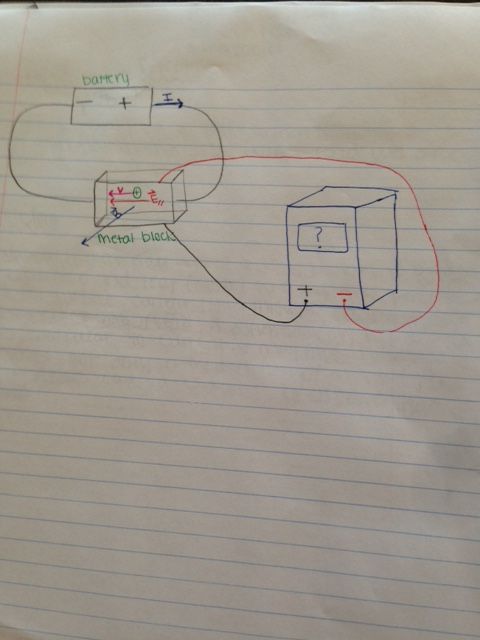Hall Effect: Difference between revisions
Kfreesemann3 (talk | contribs) No edit summary |
Kfreesemann3 (talk | contribs) |
||
| Line 30: | Line 30: | ||
Question: A battery and metal block are connected by 2 wires. Conventional current flows counterclockwise. A voltmeter is attached to the block with its positive lead at the top of the block and its negative lead at the bottom of the block. The voltmeter has a positive reading. What sign does the mobile charge have? (See attached diagram) | Question: A battery and metal block are connected by 2 wires. Conventional current flows counterclockwise. A voltmeter is attached to the block with its positive lead at the top of the block and its negative lead at the bottom of the block. The voltmeter has a positive reading. What sign does the mobile charge have? (See attached diagram) | ||
[[File: | [[File:Example.jpg]] | ||
===Difficult=== | ===Difficult=== | ||
Revision as of 21:41, 4 December 2015
Claimed by Katherine Freesemann
The Hall Effect uses the idea of Fnet being equal and Fnet being the Lorentz Force in these "Hall Effect" questions. This Fnet of zero is achieved due to the polarization properties of metal. Using what we know about how to calculate the Lorentz Force, we can determine things such as the sign of a mobile charge carrier. The Hall Voltage (which is not discussed in this Wiki Page) is a continuation of this idea of the Hall Effect and can be used to determine things such as the density of a mobile charge and can provide more information about the perpendicular electric field. This page is mainly about observations that can be made using Hall Effect without even having to calculate numbers. It is fundamental to understand this page before moving on to calculations with the Hall Effect.
The Main Idea
When a mobile charge flows through a wire or metal block and are also influenced by a magnetic force, the mobile charges begin to build up on one side or the other of the block. Because metals have the unique ability to have very mobile charges (unlike insulators) the block polarizes and has negative charges on one side and positive on the other so that the block is able to remain neutral. This grouping of positive charges in one part of the block and negative charges in another part of the block creates an electric field and thus an electric force perpendicular to the flow of the mobile charges through the wire. The magnetic and electric forces cancel each other out and after some time, the charges flow right through the block and do not group on one side or the other of the block. This perpendicular electric field also creates a potential difference known as the "Hall Voltage."
A Mathematical Model
What are the mathematical equations that allow us to model this topic. For example [math]\displaystyle{ \vec{F}_{magnetic}= \vec{F}_{electricperpendicular} }[/math] where F_magnetic is the force on the mobile charge by the magnetic field and F_electricperpendicular is the force the mobile charge experiences that is caused by the polarization of the metal.
A Computational Model
How do we visualize or predict using this topic. Consider embedding some vpython code here Teach hands-on with GlowScript
Examples
Be sure to show all steps in your solution and include diagrams whenever possible
Simple
Question: A metal slab is connected to a battery by two wires. Conventional current flows clockwise and the mobile charge in the block is positive. The block also experiences a magnetic field out of the page. The slab is also connected to a voltmeter.The positive end of the voltmeter is connected to the bottom of the block and the negative end of the voltmeter is connected to the top of the block. See attached photo for a diagram.
Answer: In order to determine this, we must determine what direction the magnetic force is. In this case, since magnetic force is qv X B, the magnetic force points up. This means that the mobile charges (positive) will be pushed towards the top of the block and the negative charge will be at the bottom of the block, so that the block will remain neutrally charged. Remember: a voltmeter will have a positive reading if the positive end is connected to the part with the larger potential. In this case, the larger potential is at the top because that is where the positive charge is, but the negative end of the voltmeter is connected there. The voltmeter will have a negative reading.
Middling
Question: A battery and metal block are connected by 2 wires. Conventional current flows counterclockwise. A voltmeter is attached to the block with its positive lead at the top of the block and its negative lead at the bottom of the block. The voltmeter has a positive reading. What sign does the mobile charge have? (See attached diagram)
Difficult
Connectedness
- How is this topic connected to something that you are interested in?
- How is it connected to your major?
- Is there an interesting industrial application?
History
The Hall Effect was discovered in 1879 by Edwin Herbert Hall while he was attending Johns Hopkins University for his Doctoral Degree. He exposed a gold leaf (metal slab) to a magnetic field perpendicular to its surface and had current flow through the slab. He observed a potential (delta V) perpendicular to the current and also the magnetic field. This means that potential is observed not only in the direction of current flow like usual. This is what led to Hall's discovery o the Hall Effect.
See also
Are there related topics or categories in this wiki resource for the curious reader to explore? How does this topic fit into that context?
Further reading
Books, Articles or other print media on this topic
External links
Internet resources on this topic
References
This section contains the the references you used while writing this page

